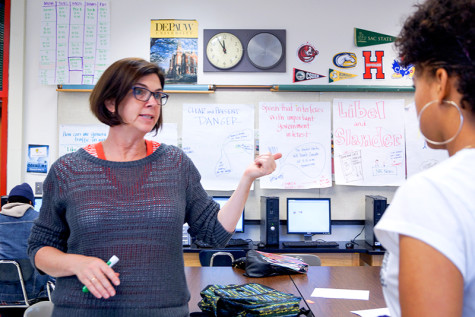Lawsuit claims Fremont High students have unequal time to learn
Lisa Shafer instructs students in her journalism class at Fremont High School.
June 5, 2014
A teacher who is party to a class action lawsuit against the State of California over equal access to secondary education says legal action is long overdue.
Lisa Shafer, the media academy director and a journalism teacher at Oakland’s Fremont High School, says the lawsuit, filed last Thursday in Alameda County Superior Court, claims the disparities between some of the urban and suburban schools in Oakland Unified School District are astonishing.
“There is no stability and lots of disruption,” Shafer said in a recent interview. “It is inequitable to be a kid in a system where there is disruption.”
The lawsuit, called Cruz et. al. v. State of California, argues that students in seven schools in the state, including Fremont High, have unfair and unequal access to meaningful learning time that is necessary for education.
The American Civil Liberties Union, along with Public Counsel, which claims to be the largest pro bono law firm in the nation, are representing students and teachers who are party to the suit. Shafer is just one of those teachers.
According to the lawsuit, the students from these seven schools are predominantly minorities and English language learners, living in areas of high crime and poverty. These students are failing academically because the state systematically fails to adequately staff and provide resources for these schools.
Kathryn Eidmann, the attorney for Public Counsel, said the suit is aimed at holding the state accountable and getting it to provide a more positive teaching environment across the board.
“The state is sending a message to the students that the time they spend in the classroom is not valuable and that coming to school does not matter,” Eidmann said in an interview.
Shafer says the challenges and inequities at Fremont manifest in many ways across the school.

“By the middle of the school year, the attendance of my junior class will drop to half because the students just stop showing up, “ she said.
The reasons for such problems include students’ home situations, lack of programs offered at Fremont and a curriculum that is in flux.
Issues include high teacher turnover rates and unstable administrative teams, uncertainty and constant change to the master course schedules throughout the school year, violence or security disruptions, unaddressed student absenteeism and students being pulled out of class to perform administrative tasks or be in free periods due to lack of faculty.
It all makes for a very difficult learning environment, the lawsuit claims.
“Teaching is hard when there are so many kids with serious issues and the problem is that these kids with the most challenges need more support,” said Shafer.
She has been at Fremont High for seven years. Before that she taught at Clayton Valley High in Concord. She was at first alarmed at the disparities between the relative wealth of the suburbs and Fremont High in East Oakland.
According to Eidmann, most of the students from the schools named in the class action suffer from traumatic disorders or mental stress because of the environment they live in outside of school.
They often come to class and act up but the school does not have the capability to provide mental health services or counseling. Instead, they are sent home or referred to Oakland police or parole officers who takes more time away from learning, argues the suit.
Shafer said she understands that these kids go through a lot at home and deal with things that are traumatic but it becomes unfair when they take these problems to class and disrupt others from the attention they need.
“It’s not fair for Mrs. Shafer because she tries but other students are always being rude and she has to babysit or stop the class to talk to them,” said Stephanie Valdez, a junior from Fremont High.
One of the main issues at a school like Fremont High is the lack of a masterschedule, which means that a principal and administration can’t adequately plan out classes and schedules for an academic year.
Because of this, the current system is ineffective at the start of the school year because there are no resources to staff or plan a curriculum, leaving students in chaos from day one, said Eidmann.
According to the suit, students from these schools are often attending the first week of instruction in chaos, placed in the wrong classes, or sitting in the gym waiting for class assignments.
To wrestle chaos into order, some students are placed in classes they do not need, sent home or asked to perform administrative tasks for the school. This perpetuates the problem of taking away countless hours from learning, the lawsuit claims.
In order to entice or motivate students to come to class, teachers are left to their own devices.
Shafer often spends her own money to buy donuts and prizes to award the students for coming to class on time.
“Using food is a great way to entice the kids whose mindset is of being somewhere you don’t want to be. If they see there is a reward they will be more motivated,” she said.
With such a heavy workload and strain on teachers to act as mentors and counselors for their students, many faculty members get burned out. The schools have high turnover rates and low retention of teachers who get fed up by the demands. The lack of faculty and perpetual rotation of substitute teachers creates inconsistent lesson plans which disrupts learning, said Eidmann.
Shafer said she lost two teachers in the media academy this year and that it is common for teachers to leave after one or two years on the job. Without a dedicated teaching staff it is difficult to meet, organize and talk about projects and plan a cohesive lesson plan, said Shafer.
Eidmann said the solution is to provide sufficient funding for more teachers and faculty and provide equipment and resources that help promote a positive and supportive work environment
The lawsuit outlines changes that are needed and asks the state to monitor areas where schools are falling below norms and implement intervention programs to ensure math and literacy standards.
It calls for hiring trained counselors for mental health support to work with children who are dealing with traumatic disorders from witnessing high rates of violence and crime. It also asks for an end to the practice of sending students home or asking them to do administrative tasks at school as filler for class time that is unfilled.
The suit asks the state to ensure that master schedules are implemented at the beginning of the school year for the schools mentioned in the lawsuit, to ensure that students are placed correctly and that their learning time is the same as with other schools in the state.
“These are things that you would see at other schools,” said Shafer.
















